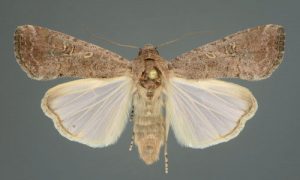
This has been a problematic year for armyworms in turfgrass. The fall armyworm is the caterpillar of a moth that returns to Georgia almost every year. Although the moths don’t survive winters, they travel north from Florida on weather fronts every spring and summer, laying eggs as they go. After several generations, the moths – and their offspring, armyworms – arrive in North Georgia in late summer or early fall.
The moth lays eggs in batches of a few dozen to several hundred, allowing populations to grow rapidly throughout the summer. Eggs hatch after a few days and the caterpillars feed and grow for 2-3 weeks before pupating. A week or so later, a new adult moth emerges, and the cycle starts again. In warm weather, the cycle takes about 4 weeks to complete.
Insecticidal control of caterpillars in turf and sod is not complicated. There are several products that are effective and relatively inexpensive; others are more expensive but offer better control of larger worms. A few products give long-term protection at a premium price. All insecticides are more effective on small worms than on mature “snakes” that are nearly ready to pupate. Pyrethroid insecticides (active ingredients that end in –thrin) are contact insecticides that also kill by ingestion if caterpillars feed on treated grass. They are off patent, so there are inexpensive and effective product options for controlling small to medium size worms. Residual activity fades after a few days in the summer environment and after mowing the lawn.
Products containing spinosad are more costly but are effective and provide longer control. However, they do not move in the plant, so they do not protect new growth. The “gold standard” is chlorotraniliprole, sold as Acelepryn and in some combination products. This material is systemic in the plant and provides a dose-dependent residual activity.
Insect growth regulators (IGR), such as Confirm and Dimilin, provide a different approach to insect control. Confirm is active only on caterpillars. Dimilin is a broad-spectrum IGR that stops development of immature insects so they cannot grow into adults. It is absorbed into the grass and remains active, but does not move into new growth. Some sod producers have begun treating sod with Dimilin before harvest as a preventative to keep any small worms from developing. It is not harmful to animals or people.

Armyworm moths are continuously flying and are attracted to young succulent grass, so infestations of newly sodded lawns are common for 30-60 days after establishment. The practices associated with establishment, like irrigation and nitrogen fertility, promote growth characterized by succulent leaves.
If armyworms are identified and controlled early, turfgrass recovery can be expected without needing to replace the sod. For insecticide application rates and directions, read the product label or see the Home Turfgrass Insect Control section of the 2021 Georgia Pest Management Handbook. As fall approaches, the armyworm life cycle typically lengthens, changing developmental timing as temperatures cool. Similarly, shorter days and cooler temperatures slow turfgrass growth.